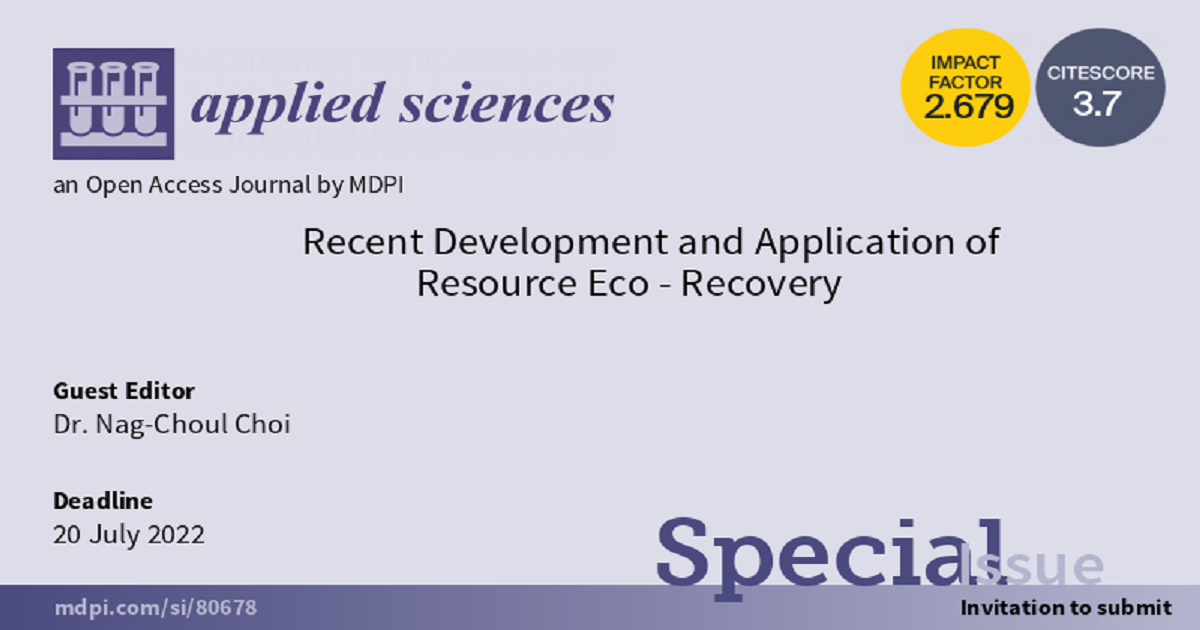Recent Development and Application of Resource Eco-Recovery
A special issue of Applied Sciences (ISSN 2076-3417). This special issue belongs to the section "Environmental Sciences".
Deadline for manuscript submissions: closed (20 July 2022) | Viewed by 3076

Special Issue Editor
Interests: biomining; waste recycling based on bioleching; new bioleaching technology
Special Issues, Collections and Topics in MDPI journals
Special Issue Information
Dear Colleagues,
The eco-recovery of resources is an eco-friendly or economical method of recovering valuable resources from sulfide minerals, which are present in solid waste and low-grade minerals.
The recovery, separation and recycling of sulfide minerals in solid resources have limitations such as their energy consumption, excessive use of chemicals, secondary pollutants, and lack of field-scale applicability for evaluation.
Therefore, a new resource eco-recovery method (biological/chemical leaching, physical/chemical concentration and separation, etc.) is needed that can circumvent or overcome these limitations.
This Special Issue entitled “Recent Development and Application of Resource Eco-Recovery” aims to reflect on the recent advancements in resource recovery, which will help to combat its associated challenges. Any submissions related to the abovementioned topics are welcome.
Dr. Nag-Choul Choi
Guest Editor
Manuscript Submission Information
Manuscripts should be submitted online at www.mdpi.com by registering and logging in to this website. Once you are registered, click here to go to the submission form. Manuscripts can be submitted until the deadline. All submissions that pass pre-check are peer-reviewed. Accepted papers will be published continuously in the journal (as soon as accepted) and will be listed together on the special issue website. Research articles, review articles as well as short communications are invited. For planned papers, a title and short abstract (about 100 words) can be sent to the Editorial Office for announcement on this website.
Submitted manuscripts should not have been published previously, nor be under consideration for publication elsewhere (except conference proceedings papers). All manuscripts are thoroughly refereed through a single-blind peer-review process. A guide for authors and other relevant information for submission of manuscripts is available on the Instructions for Authors page. Applied Sciences is an international peer-reviewed open access semimonthly journal published by MDPI.
Please visit the Instructions for Authors page before submitting a manuscript. The Article Processing Charge (APC) for publication in this open access journal is 2400 CHF (Swiss Francs). Submitted papers should be well formatted and use good English. Authors may use MDPI's English editing service prior to publication or during author revisions.
Keywords
- bioleaching
- sulfide minerals
- sulfur-oxidizing bacteria
- waste recycling
Benefits of Publishing in a Special Issue
- Ease of navigation: Grouping papers by topic helps scholars navigate broad scope journals more efficiently.
- Greater discoverability: Special Issues support the reach and impact of scientific research. Articles in Special Issues are more discoverable and cited more frequently.
- Expansion of research network: Special Issues facilitate connections among authors, fostering scientific collaborations.
- External promotion: Articles in Special Issues are often promoted through the journal's social media, increasing their visibility.
- Reprint: MDPI Books provides the opportunity to republish successful Special Issues in book format, both online and in print.
Further information on MDPI's Special Issue policies can be found here.





